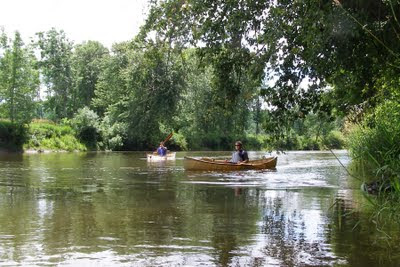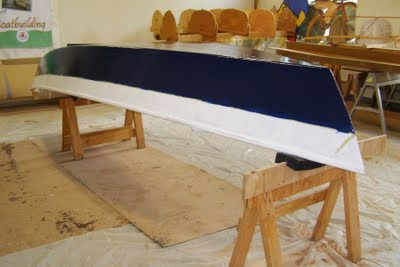11/5/11
9/9/11
Coracle Project Almost Over.
The steel coracle is finished!
http://www.steelcoracle.wordpress.com/
Video of the launching to follow shortly...
http://www.steelcoracle.wordpress.com/
Video of the launching to follow shortly...
8/11/11
NFCT (Northern Forest Canoe Trail) First Leg
Day Three

At the end of this last portage, all that remained between us and Long Lake village was a short section of quiet river and 4 miles on the southern end of Long Lake. As we entered the lake, I noticed that I seemed to be taking on more water than could be accounted for by 'paddle drip'. I pulled over at Moose Island, and sure enough, I'd finally done it! After years of bumps and scrapes, I'd finally worn a BB-sized hole in the canvas of my boat. I dried it off and applied a patch of Gorilla brand duct tape. Five minutes later I was on
my way again, good as new.
We pulled into the DEC boat ramp about 1:00 pm, just under 48 hours after we left Old Forge. Not bad for a couple of old guys. A young fellow from Paul Smith's College approached us to ask where we were from and where our boats had been; his survey was related to aquatic invasive species. We chatted for a bit, .then took our time loading up for the trip home. Lunch at the Long Lake diner was well-deserved

It rained again, overnight. All the clothes we left out to dry were wetter than before, but otherwise we were dry and rested. I heard something rustling around outside during the night, but nothing was disturbed. (By the way, last evening our two cans of beer cooling in the lake got a rise out of the duck population. Apparently they were attracted by the shiny cans, and kept swimming over to investigate).
Unfortunately, the day began with a portage. First, since we were across the outlet of the lake from the carry, we had to pack and load the boats only to paddle 50 yards to the opposite shore, where we pulled our packs out again and loaded up for a 1.3 mile carry. The terrain was good, all on dirt road, but carries are getting old. Then, we re-entered the Racquette River for the mile to Buttermilk Falls, where we had a .1 mile carry around the falls. Since this was so short, we made two trips, first with the packs and then the boats. It was also rough and steep ground, so this made better sense. I picked off one geocache by the falls.We spent some time taking in the falls and getting some pictures, then got back on the water for another half mile in a quiet, but rock-studded section of river. Our last portage (.6 miles) was perhaps the most arduous, as the trail was uneven, with rocks, roots and mud and the occasional boardwalk, which sometimes proved slippery.
At the end of this last portage, all that remained between us and Long Lake village was a short section of quiet river and 4 miles on the southern end of Long Lake. As we entered the lake, I noticed that I seemed to be taking on more water than could be accounted for by 'paddle drip'. I pulled over at Moose Island, and sure enough, I'd finally done it! After years of bumps and scrapes, I'd finally worn a BB-sized hole in the canvas of my boat. I dried it off and applied a patch of Gorilla brand duct tape. Five minutes later I was on
my way again, good as new.
We pulled into the DEC boat ramp about 1:00 pm, just under 48 hours after we left Old Forge. Not bad for a couple of old guys. A young fellow from Paul Smith's College approached us to ask where we were from and where our boats had been; his survey was related to aquatic invasive species. We chatted for a bit, .then took our time loading up for the trip home. Lunch at the Long Lake diner was well-deserved
NFCT (Northern Forest Canoe Trail) First Leg
It had stopped raining by dawn, but was overcast and damp-ish. We shook off the wet tent as much as possible and packed up. A short paddle took us under the bridge into Seventh Lake and to the inlet on the north-west corner of Eighth Lake. Here we started the first long carry, through the Eighth Lake State Campground. It would have been a mile, had we beached were the NFCT map indicated and gone straight north through the state campsite, but by going up the inlet and using a side road we saved about .4 miles (I’ve been using the measuring function in Google Earth to check distances).
The next carry was the longest: 1.25 miles (though it seemed longer). It ends with a long boardwalk through the marsh surrounding the stream and a dock at its terminus. Here we dropped our packs and loaded the boats again.
A word about our method of carries might be in order here. Folks with traditional canoes, when confronted with a portage will carry the canoes first, and make a second trip back for their supplies. Some people use little two-wheeled carts, which are compact enough to carry in a canoe or even stow in or on a kayak. On most – but not all – of our portages, this would have worked fine, as they were fairly smooth-surfaced. Our strategy, with our lightweight boats, was to pack light, and carry everything in one trip. I made yoke for the canoe Randy was using, and used the two halves of my break-apart paddle, lashed between the thwarts to perform the same function. I used my large hiking pack and clipped an old Boy Scout canvas pack to the front with the food and cook gear (sort of like wearing a sandwich-sign. It worked well enough, though if I do it again I will try to trim my pack weight even more.
Brown’s Tract Inlet, the stream we now entered, winds circuitously a couple of miles to Racquette Lake. We crossed four beaver dams, plus one half begun and apparently abandoned, on our way to the lake. Twice we had to step out of our boats onto the dam and re-enter downstream. On the other dams we could remove a few sticks and create a sluice through which it was possible to run (with a little scraping) the canoes. The waterway was so crooked, that it was long after we could see a church and power lines in the village of Racquette Lake that we reached the big open waters of the lake.
I was afraid we might have difficulty here, as Racquette is a big lake, and notoriously windy, but it was tame compared to our first day’s paddle. This was a long stretch – seven miles to the next stop and carry. Much of the shoreline is privately owned land, so we ate our lunch floating in the boats, shifting around to try and rest our backsides. From the northern outlet, there is a half-mile carry to Forked Lake, and then a 3.5 mile stretch to the Forked Lake State Campsite. This is a nice campground. All the sites, which are roomy and have their own privies, are ranges down the south and eastern shore of the lake and even across its North
Bay, some only accessible by boat from the camp center.
At this point, the weather was fine, and it was still early (6:00 pm?). We pitched our tent to air out, hung our wet gear and went to work on dinner.
8/9/11
NFCT (Northern Forest Canoe Trail) First Leg
Old Forge NY to Long Lake NY
Day One
My brother Randy and I just finished the first leg of the Northern Forest Canoe Trail. We left Lakeville at 6:00 am on Saturday morning, arriving in Long Lake about 10:00 am. After an early lunch in the diner, we drove down to the D.E.C. boat ramp to wait for our shuttle ride to Old Forge. We left the car in the Long Lake parking lot, so we could easily head for home when the trip was over.
There was another group — two men and their sons — getting picked up who had just done the trip were about to start. These were the only other ‘through paddlers’ we saw this trip and it turned out they were from Torrington, CT, and knew some of the same people as Randy.
We got dropped off at Old Forge and were on the water by 1:30 pm. on Saturday. From Old Forge Pond, it’s about a mile down to First Lake (of eight) on what is known as the Fulton Chain. As we started across the lake, I was amazed at how rough the water was. Many large motor craft, going in all directions, created seas not unlike what I’ve seen off Gloucester, MA in my kayak. Our little skin-on-frame canoes, handled it all quite well, even when we took some splashes right over the bow. First, Second and Third Lakes are almost continuous open water until a narrow channel leads into Fourth Lake which is the biggest, though it was much more sedate.
 |
| Packing up for our first portage. |
7/30/11
Visit to Manzanita, Oregon
While on a family vacation in Oregon, I realized we were next door to Cape Falcon Kayak, so I went over to check them out. On a Thursday, a class of six were coating the skins of their kayaks. We watched for a while and admired the boats.
 |
| Greenland-style kayak |
 |
| Skin-on-frame Adirondack Guide Boat |
 |
| Owner/teacher Brian Shultz applying polyurethane 'goop'. |
 |
| Boats turned to coat decks. |
7/3/11
Summer paddle
6/4/11
5/31/11
BOAT LAUNCHNG
Jimmy Skiff, built by Jesse Langer '11
 |
| CLC Jimmy Skiff |
This turned out to be almost a harder job to paint than to build. I went together very quickly (we worked within the school schedule of 4 x 45 minutes plus 1 x 75 minute block. We learned, first and foremost, that if you are nor going to do a carefully neat job with the epoxy fillets, you'd better be resigned to a lot of rasping and sanding in tight places.
Nevertheless, it came out looking pretty good and is a nice little boat. This is a 'stitch-and-glue' kit from Chesapeake Light Craft.
The boat behind is, of course, one of our skin-on-frame boats with a silver-grey acid dye, coated with the Skinboat Store's 2-part polyurethane and ash rub rails.
5/29/11
5/24/11
Down to the wire
These photos are only slightly out of date, but things are moving quickly. The white boat (for now) is fully skinned, and waiting for dye and shrinking. The skiff is right-side-up and fully painted -awaiting oarlocks. The kayak is rigged with deck lines and hatch straps.
Looks like all the boats will be ready for launching on the 31st of May.
4/28/11
This weekend, I am heading to the Yestermorrow Design/Build School in Waitsfield, VT.
I’ll be helping to build a willow ribbed canoe with Hilary Russell, who got me started building skin-on-frame canoes. This boat will look much like our boats, but instead of having steamed cedar ribs, it will be ribbed with willow rods. Also, in keeping with Yestermorrow’s ethos, this will be made with ‘greener’ sustainable materials: a 12’ board; forty willow rods for the ribs; water-based glue; tarred cotton twine for lashing; some scrap wood, and a length of cotton canvas. By applying both Celtic and Native American methods and designs, we will produce a 10½’ by 27” wide double paddle canoe weighing about 18 pounds.
4/16/11
3/10/11
March Break
2/22/11
1/27/11
Makin' Progress
Subscribe to:
Posts (Atom)













































